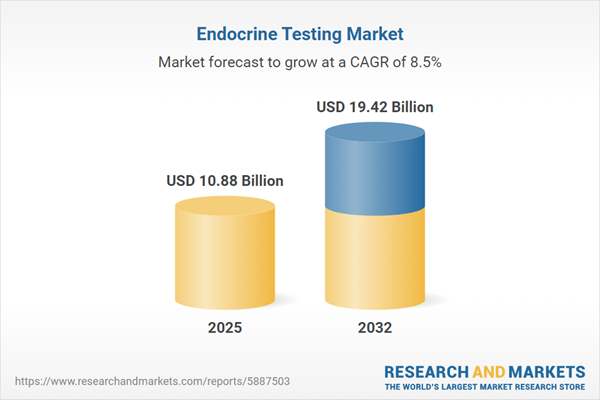Speak directly to the analyst to clarify any post sales queries you may have.
The endocrine testing market is evolving rapidly, with healthcare organizations integrating digital diagnostics, advanced laboratory technologies, and updated regulatory frameworks. Leaders navigating this environment must strategically align growth initiatives with developments in diagnostics and compliance to maintain operational excellence and competitiveness.
Market Snapshot: Global Endocrine Testing Market Size & Growth
In 2024, the global endocrine testing market is valued at USD 10.07 billion, with forecasts suggesting an increase to USD 10.88 billion by 2025. This growth reflects an 8.54% compound annual growth rate, setting the stage for significant sector expansion and an estimated worth of nearly USD 19.42 billion by 2032. Expansion is supported by a wider adoption of hormone diagnostics, ongoing technological advancements in laboratory systems, and strengthened regulatory backing. Many organizations are channeling resources into upgraded analytical instruments and scalable digital platforms, helping to streamline diagnostic delivery and address new compliance requirements.
Scope & Segmentation: Endocrine Testing Market Coverage
A clear segmentation approach enables senior decision-makers to direct efforts and resources for optimal impact. The market’s primary segments include the following:
- Test Types: Includes major hormone assays such as cortisol, DHEAS, estradiol, hCG, insulin, sex hormones, and TSH for diagnosing a wide range of endocrine conditions.
- Product Types: Encompasses laboratory instruments like chromatography systems, immunoassay analyzers, and mass spectrometers, supported by reagents, test kits, and automation solutions for improved workflow and regulatory compliance.
- Sample Types: Covers blood, saliva, and urine collection methods that allow adaptation to diverse clinical and patient needs.
- Technologies: Includes clinical chemistry analyzers, immunoassay platforms, sensor-based detection, antibody assays, and tandem mass spectrometry for enhanced diagnostic precision and throughput.
- Disease Focus: Targets diagnostic solutions for adrenal disorders, diabetes, thyroid diseases, and gonadal conditions, informing product development and patient care strategies.
- End Users: Covers diagnostic laboratories, hospitals, clinics, academic health centers, and research organizations, each with unique integration and workflow needs.
- Regional Coverage: Considers operational variations across the Americas, Europe, Middle East and Africa, and Asia-Pacific, reflecting regional regulations, infrastructure, and market dynamics.
Endocrine Testing Market: Key Takeaways for Decision-Makers
- Expansion of point-of-care and digital diagnostics supports early disease detection and encourages value-based care transitions within healthcare systems.
- Adopting multiplex platforms and mass spectrometry helps organizations adapt to novel clinical requirements and improve laboratory turnaround times.
- Collaboration with regulatory agencies and industry players strengthens supply chain stability, ensuring organizations remain responsive to reimbursement and compliance shifts.
- Decentralized and community-focused diagnostic models increase accessibility for underserved populations and enhance operational flexibility.
- Shifting toward noninvasive sample collection, especially saliva-based methods, streamlines laboratory workflows and supports broader adoption of preventive health initiatives.
- Customizing regional operational models allows organizations to compete effectively, fostering partnerships that accommodate diverse health and regulatory systems.
Tariff Impact on Supply Chain & Cost Structures
Recent U.S. tariff policy changes have led manufacturers in the endocrine testing sector to reevaluate production and distribution strategies. Adjustments such as relocating manufacturing sites, renegotiating supplier contracts, and optimizing inventory logistics are designed to enhance reliability and maintain cost-effectiveness. Service providers are also refining their operational models to support clients’ agility as supply chain and regulatory environments evolve.
Methodology & Data Sources
Findings in this report are based on direct interviews with leading industry experts and thorough secondary research. Detailed scenario analyses, comprehensive regulatory reviews, and proprietary datasets underpin focused, actionable insights for executive decision-making.
Why This Endocrine Testing Market Report Matters
- Supports leadership in aligning technology adoption and organizational strategies with evolving regulatory and reimbursement trends.
- Provides segmentation analysis to prioritize investments and develop targeted commercial plans by region and by product category.
- Enables stakeholders to optimize infrastructure, build effective collaborations, and adapt operations to industry changes with robust market intelligence.
Conclusion
This report equips senior executives with the targeted market insights necessary to coordinate effective strategies, adapt to regulatory developments, and maintain sustainable growth as endocrine testing continues to transform global healthcare landscapes.
Additional Product Information:
- Purchase of this report includes 1 year online access with quarterly updates.
- This report can be updated on request. Please contact our Customer Experience team using the Ask a Question widget on our website.
Table of Contents
3. Executive Summary
4. Market Overview
7. Cumulative Impact of Artificial Intelligence 2025
Companies Mentioned
The companies profiled in this Endocrine Testing market report include:- Bio-Rad Laboratories Inc
- bioMérieux SA
- Abbott Laboratories
- ACON Laboratories, Inc.
- Agilent Technologies, Inc.
- BioCheck Inc.
- Biogenix Inc. Pvt. Ltd
- Blueprint Genetics Oy
- Creative Diagnostics
- Danaher Corporation
- Diagnostic Automation/Cortez Diagnostics Inc.
- DiaSorin S.p.A.
- Eagle Biosciences
- EKF Diagnostics Holdings PLC
- Eurofins Analytical Laboratories Inc.
- Getein Biotech, Inc.
- Laboratory Corporation of America Holdings
- MP Biomedicals, LLC
- Ortho-Clinical Diagnostics, Inc.
- Quest Diagnostics Incorporated
- Randox Laboratories Ltd.
- Shenzhen New Industries Biomedical Engineering Co., Ltd.
- Siemens Healthcare GmbH
- Thermo Fisher Scientific Inc.
- Trivitron Healthcare
- Eli Science Inc.
- F. Hoffmann-La Roche Ltd
Table Information
| Report Attribute | Details |
|---|---|
| No. of Pages | 194 |
| Published | November 2025 |
| Forecast Period | 2025 - 2032 |
| Estimated Market Value ( USD | $ 10.88 Billion |
| Forecasted Market Value ( USD | $ 19.42 Billion |
| Compound Annual Growth Rate | 8.5% |
| Regions Covered | Global |
| No. of Companies Mentioned | 28 |









